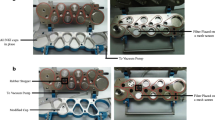Abstract
The purpose of this article is to investigate the performance of multivariate data analysis, especially orthogonal partial least square (OPLS) analysis, as a semi-quantitative tool to evaluate the comparability or equivalence of aerodynamic particle size distribution (APSD) profiles of orally inhaled and nasal drug products (OINDP). Monte Carlo simulation was employed to reconstitute APSD profiles based on 55 realistic scenarios proposed by the Product Quality Research Institute (PQRI) working group. OPLS analyses with different data pretreatment methods were performed on each of the reconstituted profiles. Compared to unit-variance scaling, equivalence determined based on OPLS analysis with Pareto scaling was shown to be more consistent with the working group assessment. Chi-square statistics was employed to compare the performance of OPLS analysis (Pareto scaling) with that of the combination test (i.e., chi-square ratio statistics and population bioequivalence test for impactor-sized mass) in terms of achieving greater consistency with the working group evaluation. A p value of 0.036 suggested that OPLS analysis with Pareto scaling may be more predictive than the combination test with respect to consistency. Furthermore, OPLS analysis may also be employed to analyze part of the APSD profiles that contribute to the calculation of the mass median aerodynamic diameter. Our results show that OPLS analysis performed on partial deposition sites do not interfere with the performance on all deposition sites.





Similar content being viewed by others
References
Adams WP, Christopher D, Lee DS, Morgan B, Pan Z, Singh GJ, et al. Product Quality Research Institute evaluation of cascade impactor profiles of pharmaceutical aerosols, part 1: background for a statistical method. AAPS PharmSciTech. 2007;8:4.
Hickey AJ. Pulmonary drug delivery-pharmaceutical chemistry and aerosol technology. In: Wang B, Siahaan T, Soltero R, editors. Drug delivery: principles and applications. New York: Wiley; 2005. p. 341–61.
Hickey AJ, Kazantseva M, Garcia-Contreras L. Debugging the lungs: the use of therapeutic aerosols in the treatment of pulmonary infectious diseases. In: Smith SR, Paul-Aviles F, Liu J, editors. Pharmaceutical approaches to infectious disease therapy. Godalming: Horwood; 2002. p. 67–93.
Hickey AJ. Summary of common approaches to pharmaceutical aerosol administration. In: Hickey AJ, editor. Pharmaceutical inhalation aerosol technology. 2nd ed. New York: Marcel Dekker; 2004. p. 385–421. 385–421.
Tsong Y. Statistical comparison of particle size distribution profiles. 2004; Available at: http://pqri.org/commworking/minutes/pdfs/dptc/psdpcwg/Addl/DC01-475116-v2-Yi_Tsong_Statistical_Archive_PQRI_Profile_Comparisons.DOC. Accessed June 22, 2007.
FDA/CDER. Draft guidance for industry: bioavailability and bioequivalence studies for nasal aerosols and nasal sprays for local action. Food and Drug Administration Web site. 1999; Available at: http://www.fda.gov/cder/guidance/2070DFT.pdf. Accessed March 28, 2007.
FDA. CDER. Statistical information from the June 1999 Draft Guidance and Statistical Information for In Vitro Bioequivalence Data Posted on August 18, 1999. Available at: http://www.fda.gov/cder/guidance/5383stats.pdf. Accessed January 14, 2007.
United States Pharmacopeial Convention. Chapter 601. Aerosols, metered-dose inhalers, and dry powder inhalers. In: USP30-NF25. Rockville, MD: USP;2007. 220–240.
P.P. DeLuca, Lyapustina, S. Product Quality Research Institute reports. AAPS PharmSciTech [serial online]. 2007;8:article 6.
PQRI APSD Profile Comparisons Working Group. SAS code implementing the chi-square ratio method. 2006; Available at: http://www.pqri.org/structure/psdp.asp. Accessed May 29, 2007. Accessed May 29, 2007.
Christopher D, Adams WP, Lee DS, Morgan B, Pan Z, Singh GJ, et al. Product Quality Research Institute evaluation of cascade impactor profiles of pharmaceutical aerosols, part 2: evaluation of a method for determining equivalence. AAPS PharmSciTech. 2007;8:5.
PQRI Profile Comparisons Working Group. Systematic study of 38 scenarios. 2005; Available at: http://pqri.org/commworking/minutes/pdfs/dptc/psdpcwg/Addl/38%20Systematic%20Scenarios.pdf. Accessed November 1, 2006.
PQRI APSD Profile ComparisonsWorking Group. Description of the PBE approach. 2007; Available at: http://www.pqri.org/commworking/minutes/pdfs/dptc/psdpcwg/Addl/DC01-526048-v1-PBE_Description_for_PQRI_Prof_Comp.pdf. Accessed May 29, 2007. Accessed May 29, 2007.
Christopher D, Adams W, Amann A, Bertha C, Byron PR, Doub W, et al. Product Quality Research Institute evaluation of cascade impactor profiles of pharmaceutical aerosols, part 3: final report on a statistical procedure for determining equivalence. AAPS PharmSciTech. 2007;8:E90.
Eriksson L, Johansson E, Kettaneh-Wold N, Trygg J, Wikstrom C, Wold S. Multi- and megavariate data analysis. Part 1. Basic principles and applications. Second Revised and Enlarged Edition. Umetrics Academy. 2006.
PQRI Profile Comparisons Working Group. Realistic scenarios 1-33 of 55. 2005; Available at: http://pqri.org/commworking/minutes/pdfs/dptc/psdpcwg/Addl/Realistic%20Scenarios%201-33%20of%2055.pdf. Accessed October 19, 2006.
PQRI Profile Comparisons Working Group. Realistic scenarios 34-55 of 55. 2005; Available at: http://pqri.org/commworking/minutes/pdfs/dptc/psdpcwg/Addl/Realistic%20Scenarios%2034-55%20of%2055.pdf. Accessed October 19, 2006.
Rochfort S. Metabolomics reviewed: a new “omics” platform technology for systems biology and implications for natural products research. J Nat Prod. 2005;68:1813–20.
van den Berg RA, Hoefsloot HC, Westerhuis JA, Smilde AK, van der Werf MJ. Centering, scaling, and transformations: improving the biological information content of metabolomics data. BMC Genomics. 2006;7:142.
Noda I. Scaling techniques to enhance two-dimensional correlation spectra. J Mol Struct. 2008;883:216–27.
Shi S, Ashley ES, Alexander BD, Hickey AJ. Initial characterization of micafungin pulmonary delivery via two different nebulizers and multivariate data analysis of aerosol mass distribution profiles. AAPS PharmSciTech. 2009;10:129–37.
Acknowledgment
The authors gratefully acknowledge the comments and suggestions of Dr. Thomas O’Connell, Dr. Walter Hauck, and Mr. David Christopher on drafts of this manuscript.
Author information
Authors and Affiliations
Corresponding author
Rights and permissions
About this article
Cite this article
Shi, S., Hickey, A.J. Multivariate Data Analysis as a Semi-quantitative Tool for Interpretive Evaluation of Comparability or Equivalence of Aerodynamic Particle Size Distribution Profiles. AAPS PharmSciTech 10, 1113–1120 (2009). https://doi.org/10.1208/s12249-009-9303-5
Received:
Accepted:
Published:
Issue Date:
DOI: https://doi.org/10.1208/s12249-009-9303-5




